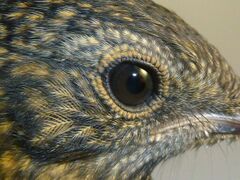Biology:Eye-ring

The eye-ring of a bird is a ring of tiny feathers that surrounds the orbital ring,[5] a ring of bare skin immediately surrounding a bird's eye.[5][6] The eye-ring is often decorative, and its colour may contrast with adjoining plumage.[4] The ring of feathers is sometimes incomplete, forming an eye arc. In the absence of a conspicuous eye-ring, the orbital ring of a bird is often referred to as the eye-ring.[4][7][8][9] The bare orbital ring may be hardened or fleshy, or may form an eye-wattle. These are useful field marks in many bird species,[8][10] and the eye-ringed flatbill, eye-ringed tody-tyrant and eye-ringed thistletail are examples of species named for either of these.
Function
Eye-rings are believed to convey various types of signals between individual birds. Some eye-rings appear only at sexual maturity, while others suggest the individual's age or health status. Individual birds may be included or excluded from reproductive capability due to signals conveyed by the eye-ring. Red carotenoid-based colors of the orbital rings of pheasants are known to be related to health.[11]
The function of the white eye-rings in white-eyes is unknown. It is suspected that they may serve to highlight infestations of small ectoparasites around the eyes. Untainted white eye-rings may consequently express vigorous health. In addition they may signal membership of a particular group or population, as different species and populations may have rings of differing colour, size, shape or completeness. These recognition signals could then play a role in reproductive isolation and speciation.[11]
Gallery
Robin-chat species, with a double ring of small feathers about the eye
Eye arcs above and below the eye of a male MacGillivray's warbler
A male blackbird with distinct yellow orbital ring
See also
References
- ↑ Dutson, Guy; Allen, Richard (2011). Birds of Melanesia the Bismarcks, Solomons, Vanuatu and New Caledonia. London: Christopher Helm. p. 402. ISBN 9781408152461. https://archive.org/details/birdsmelanesia00guyc.
- ↑ "Australian yellow white-eye (Zosterops luteus)". http://www.arkive.org/australian-yellow-white-eye/zosterops-luteus/. Retrieved 2 March 2017.
- ↑ Campbell, Bruce; Lack, Elizabeth (2010). A Dictionary of Birds. London: A & C Black. p. 307. ISBN 9781408138380.
- ↑ 4.0 4.1 4.2 Carnaby, Trevor (2008). Beat about the bush: Birds (1st ed.). Johannesburg: Jacana. pp. 9–10, 31. ISBN 9781770092419.
- ↑ 5.0 5.1 Borrow, Nik; Demey, Ron (2013). Field Guide to the Birds of Ghana. Bloomsbury Publishing. p. 24. ISBN 9781408189023.
- ↑ Vinicombe, Keith; Harris, Alan; Tucker, Laurel (2014). The Helm guide to bird identification: an in-depth look at confusion species. London: Christopher Helm. p. 14. ISBN 9781408130353.
- ↑ Mayntz, Melissa (2017-02-22). "Lores". https://www.thespruce.com/identifying-bird-lores-385299. Retrieved 1 March 2017.
- ↑ 8.0 8.1 Zimmerman, Dale A. (1999). Birds of Kenya and Northern Tanzania. Princeton University Press. pp. 43–45. ISBN 0691010226.
- ↑ Kamm, Matthew; Kuss, Benjamin. "Glossary". Brandeis University. http://www.bio.brandeis.edu/fieldbio/Birds_Kamm_Kuss/Pages/PAGE_GLOSSARY.html. Retrieved 13 March 2017.
- ↑ Birdsley, Jeff. "IB 461: Ornithology, External Anatomy". School of Integrative Biology, University of Illinois Urbana-Champaign. http://www.life.illinois.edu/ib/461/External_Anatomy.pdf. Retrieved 13 March 2017.
- ↑ 11.0 11.1 Filardi, Chris. "Answering Questions About Island Species". https://scientistatwork.blogs.nytimes.com/2011/02/25/answering-questions-about-island-species/. Retrieved 2 March 2017.
 |







